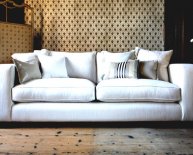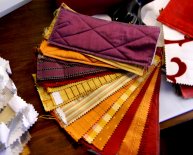
Synthetic cotton
 The goal of our Know Your Fibers series is to provide info about different types of fibers for our readers. This quarter, we’ll take a look at how cotton compares to synthetic fibers.
The goal of our Know Your Fibers series is to provide info about different types of fibers for our readers. This quarter, we’ll take a look at how cotton compares to synthetic fibers.
The Process Behind Man-Made Fibers
To start, it's important to understand that man-made synthetic fibers are produced by reactions of oil-based products that produce polymer pellets (plastic). These pellets are purchased from the pellet manufacturers (such as ExxonMobil, BP, Shell, etc.) by the fiber manufacturer (and in some cases, they may do all of this in-house). The polymer pellets are then heated to transform the polymer into a liquid or fluid state.
Afterwards, the liquid polymer is forced through a head that has small holes in it, producing small, continuous strands of fiber that are hardened back to solid polymer once they cool. The strands are then collected and cut to the desired fiber length. These cut fibers are called staple fibers (since they have two ends). If the strands are collected uncut, that is considered a continuous monofilament fiber (for a visual, think of a fishing line.)
Not All Fibers Are Measured Equally
These synthetic staple fibers are commonly used to produce popular nonwoven fabrics like polyester, polypropylene, nylon, and Kevlar™. But while synthetic fibers can be made to any diameter (denier) up to a point—just by changing the diameter of the holes—cotton diameter is not measured in denier. Cotton is classified by micronaire, which relates to diameter (to get an estimate of the denier value, you can divide micronaire by 2.82). Most cotton grown is in the 3 to 5 micronaire range, but there are also cottonseed varieties that will produce cotton in the 7 to 8 micronaire range.
With synthetic staple fibers, you can exert control over size; they can be cut to any desired length for consistency. Cotton fibers have a length distribution, so all fibers are not the same length. Cotton is sold based on the average length of the longest 25% of the fibers ranging from 0.8 to 1.2 inches, while Pima and Egyptian cotton can be up to 1.5 inches long.
Comparing Fiber Properties
Strength: Synthetic fibers are known for being stronger than cotton fibers. However, cotton fiber fabric can be strengthened by replacing some of the cotton with synthetic fiber, which ultimately creates a fabric made from a fiber blend. Cotton blends well with all synthetic staple fibers.
Thermoplasticity: Synthetic fibers are considered thermoplastic. One key property of thermoplastic materials is that they get stiff once they go below a certain temperature. This temperature is different for each fiber type. If you've ever worn a nylon shell ski jacket, you've probably felt it get stiff and make a crisp sound when you move. Cotton obviously does not get stiff, no matter the temperature.
Melting Temperature: On the other end of the temperature spectrum, manmade fibers are also more sensitive to heat. Compared to natural fibers, they burn and melt more easily.
Absorbency: Since synthetic fibers are made from oil-based products, they do not like water and are nonabsorbent. Purified cotton is very absorbent—though it can be manufactured to be nonabsorbent for certain applications.
Biodegradation: The use of plastic in synthetic fibers means that it’s not remotely as biodegradable as natural fibers. Obviously, this means once discarded it will remain in landfills for many years to come.
In the end, there’s enough room for all fibers. In fact, blending synthetic fibers with cotton can produce products with many desired and unique properties that the fibers would never possess on their own. From here, it’s up to you to determine which you’d prefer to use a consumer. For product developers, the fiber type and quantity blended will always depend on the distinct fabric properties that you are seeking.

















